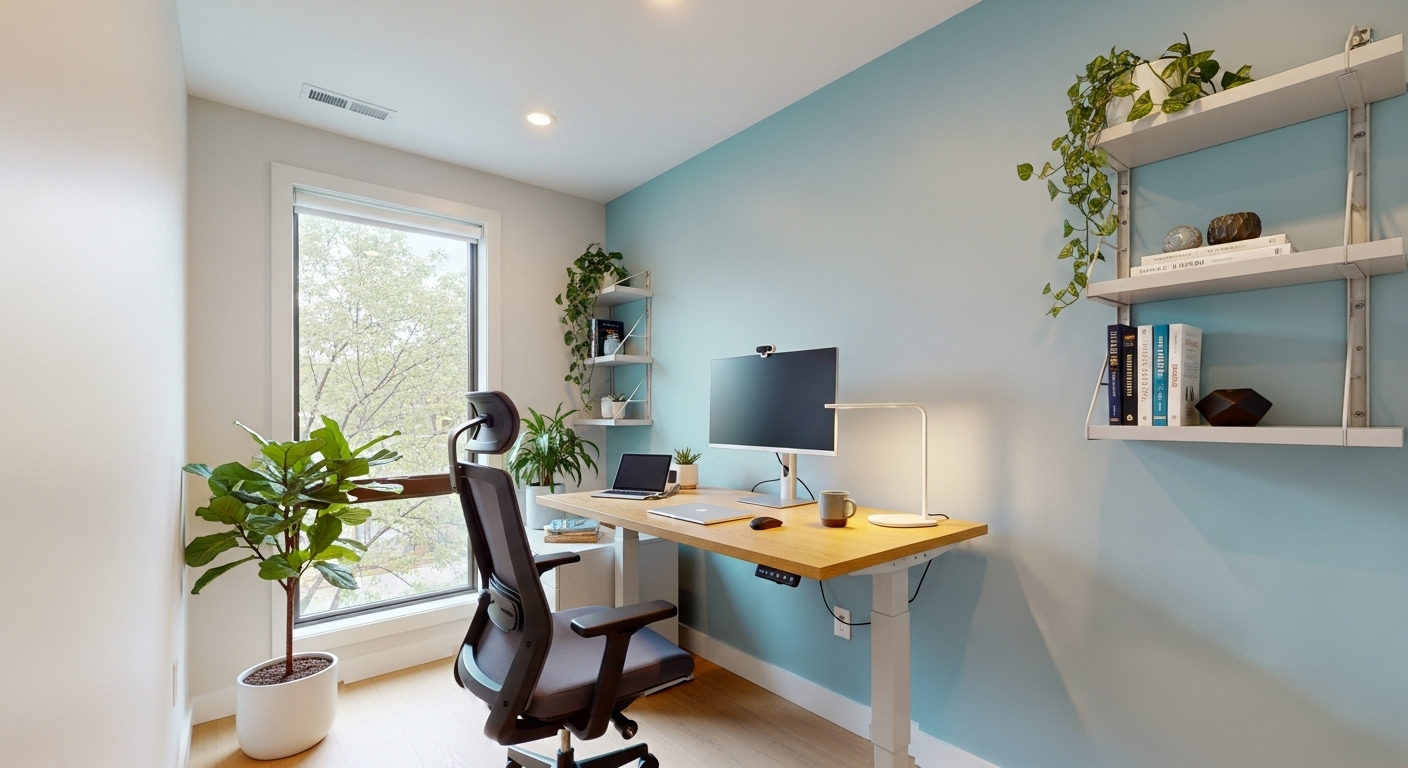The modern coworking space presents a fascinating paradox. It is an environment meticulously designed for work, yet it is often teeming with the very things that can derail it: social chatter, constant movement, and the irresistible pull of a vibrant community. For many freelancers, remote workers, and small teams, the challenge is not simply finding a desk, but mastering the dynamic environment itself. Thriving in this setting isn’t a matter of chance; it requires conscious effort and strategic design. It demands that you become the architect of your own productivity, building a personal framework that filters out the noise and harnesses the ambient energy for peak performance. This isn’t about isolating yourself with noise-canceling headphones 24/7. It’s about creating a sophisticated personal system—a ‘social architecture’—that allows you to seamlessly switch between deep, focused work and valuable community engagement. In this guide, we will deconstruct the elements of this framework, exploring how to choose the right environment, design your personal workspace, manage social energy, and implement powerful rituals that transform your coworking space from a potential distraction into your greatest productivity asset.
Laying the Foundation: Choosing a Space That Aligns with Your Workflow
Before you can build your focus framework, you must select the right plot of land. Not all coworking spaces are created equal; they each possess a unique culture, energy level, and physical layout that can either support or sabotage your productivity. Making the right choice is the foundational step in your social architecture. Start by moving beyond the glossy photos and free coffee promises. Your primary goal is to assess the space’s ‘work-life’ pulse. Is it a high-energy, sales-focused hub filled with constant calls and collaborative buzz, or does it cultivate a more subdued, library-like atmosphere? Neither is inherently better, but one will undoubtedly suit your specific needs more than the other. The best way to gauge this is to schedule tours during the times you plan to work most. Visiting at 10 AM on a Tuesday will give you a far more accurate picture than a quiet Saturday afternoon. Observe the members: are they heads-down with headphones on, or are they engaged in frequent, spontaneous conversations? Listen to the ambient sound level. Your personal tolerance for noise is a critical factor. Next, scrutinize the physical architecture of the space. Look for evidence of ‘zoned’ design. A well-thought-out coworking space will offer a variety of environments under one roof. Are there clearly designated quiet zones where conversation is forbidden? Are there enough private phone booths to make calls without disrupting others or feeling self-conscious? Do they offer bookable meeting rooms for client calls or collaborative sessions? The availability of these different zones allows you to match your environment to your task—a crucial element for sustained focus. Finally, consider the productivity-focused amenities. While ping-pong tables are fun, rock-solid, high-speed Wi-Fi is non-negotiable. Are the chairs ergonomic for long work sessions? Do they offer external monitors for rent? These practical tools can have a significant impact on your daily comfort and output. Choosing a space is not a passive decision; it’s your first active step in designing a productive work life.
Designing Your Personal Workspace: The ‘Desk as a Cockpit’ Method
Once you’ve chosen your coworking space, your next task is to carve out a personal sanctuary within it. Think of your designated desk or hot-desking spot not just as a temporary surface, but as your personal cockpit—a command center optimized for control and focus. Consistency is key to this approach. If possible, try to claim the same desk or area each day. This simple act reduces cognitive load; you’re not spending mental energy each morning deciding where to sit. This consistency helps build a powerful psychological trigger, signaling to your brain that when you are in this spot, it’s time for deep work. Your ‘cockpit’ is only as good as its equipment. Given that you’re likely carrying your office on your back, curating an essential ‘go-bag’ is critical. This kit should be built around minimizing physical discomfort and digital distractions. The absolute cornerstone is a pair of high-quality, noise-canceling headphones. They are the most powerful tool for creating an instant bubble of focus. Beyond that, consider ergonomics: a lightweight, portable laptop stand prevents neck strain, and a compact external keyboard and mouse can stave off wrist fatigue. These small investments pay huge dividends in comfort and endurance over an eight-hour day. Your physical cockpit must be paired with a digital one. This means creating a ‘digital bubble’ of focus on your laptop. Use browser extensions to block distracting websites during specific work blocks. Consider focus applications like Freedom or Forest that temporarily disable notifications across your devices. Setting up different browser profiles—one for work with only essential bookmarks and extensions, and another for personal use—can create a powerful psychological separation. Finally, use your physical setup to send clear social cues. The simple act of putting on your headphones is the universally understood sign for ‘I’m in the zone, please do not disturb.’ This non-verbal communication is a pillar of your social architecture, allowing you to manage interruptions without ever having to say a word.
Mastering Time and Energy: The Rhythms of a Shared Office
Every coworking space has its own unique rhythm, an ebb and flow of energy that pulses throughout the day. The savvy professional doesn’t fight this rhythm; they learn to surf it. By aligning your tasks with the natural energy shifts of the environment, you can significantly enhance your focus and efficiency. Pay attention to the daily patterns. Typically, there’s a morning rush as members arrive and caffeinate, a distinct lull around lunchtime, a period of deep focus in the mid-afternoon, and a winding down as the day concludes. Your goal is to map your own to-do list onto this environmental energy map. Schedule your most demanding, deep-work tasks—writing, coding, strategic planning—for the quietest periods. Early mornings, just after the lunch rush, or later in the afternoon are often prime times for concentration. Conversely, reserve the high-traffic, more chaotic periods for your shallow work. Answering emails, scheduling meetings, or doing administrative tasks don’t require the same level of intense focus and are less likely to be derailed by a nearby conversation. This strategy of ‘task-energy alignment’ is far more effective than trying to force deep work when the environment is at its most distracting. To add structure to these energy blocks, employ a time management technique like the Pomodoro Method. Working in focused 25-minute sprints with 5-minute breaks creates a personal rhythm within the larger office rhythm. These short, built-in breaks are crucial. Instead of viewing breaks as something that happens when you get distracted, schedule them intentionally. Use these 5-minute pauses to stand up, stretch, grab a glass of water, or even have that quick chat with a neighbor. By scheduling your social interactions into your break times, you transform them from interruptions into planned moments of connection, giving you control over your social energy expenditure.
The Art of Social Navigation: Managing Connections Without Killing Concentration
The greatest asset of a coworking space is its community; paradoxically, it is also its greatest potential threat to productivity. Mastering the art of social navigation is the core of building an effective ‘social architecture.’ It’s about striking a delicate balance: reaping the benefits of connection and collaboration without letting your day devolve into a series of unstructured conversations. The key is to shift from reactive socializing to proactive networking. Reactive socializing happens when you let unplanned interruptions dictate your social interactions. Proactive networking is when you intentionally schedule and seek out these connections on your own terms. A powerful tactic is to schedule your social time. If you meet someone interesting, don’t stop your work for a 30-minute chat. Instead, say, ‘I’m deep in a project right now, but I’d love to hear more. Are you free to grab a coffee around 11?’ This respects your own focus and the other person’s time, while still fostering connection. Another critical skill is mastering the polite exit. When a conversation is dragging on and you need to get back to work, have a few pre-prepared lines. Something as simple as, ‘It was great chatting, but I have a deadline I really need to get back to. Let’s catch up later!’ is effective and professional. It sets a clear boundary without being rude. Leverage the structured social events organized by the coworking space. Attending the weekly happy hour, a lunch-and-learn workshop, or a networking breakfast allows you to fulfill your need for social interaction in a context designed for it, freeing up your work hours for pure focus. Ultimately, your reputation becomes part of your focus strategy. By being friendly and approachable during breaks and community events, but visibly focused and disciplined during work hours, you teach others how to interact with you. They will learn to respect your ‘headphones on’ signal because they know you’re genuinely open to connecting at a more appropriate time.
Rituals and Routines: Bookending Your Day for Maximum Focus
Your productive day in a coworking space doesn’t begin when you open your laptop or end when you close it. The most focused professionals understand that productivity is supported by powerful rituals that ‘bookend’ the workday. These routines create clear transitions between work life and home life, prime your brain for focus, and provide a sense of closure that prevents mental clutter. It starts with the ‘commute.’ Whether you’re walking, biking, or taking public transport, treat this time as a preparatory phase. Instead of scrolling through social media, use your commute to mentally plan your day. Review your top three priorities, listen to an industry-related podcast, or simply enjoy a few minutes of mindfulness to clear your head. This transforms dead time into a deliberate ramp-up for the work ahead. Upon arrival, execute a consistent ‘setup ritual.’ This should be a short, 5-10 minute routine that you perform every single time. It could be as simple as: unpack your bag, get a coffee or tea, fill your water bottle, sit at your desk, and write down your single most important task for the day. This sequence of actions acts as a powerful psychological cue, signaling to your subconscious that the workday has officially begun and it’s time to engage. The shutdown ritual at the end of the day is arguably even more important. Resista the urge to slam your laptop shut and rush out the door. Dedicate the last 10-15 minutes of your day to a structured wind-down. First, tidy your workspace. Second, review what you accomplished against your plan for the day—this provides a sense of accomplishment. Third, and most critically, briefly plan your top priorities for tomorrow. This ‘brain dump’ externalizes your to-do list, preventing tasks from swirling in your head all evening. Finally, pack your bag completely. When you walk out the door, you are truly done. This closure is essential for preventing work creep and ensuring you return the next day feeling refreshed and ready, rather than disorganized and already behind.
Leveraging the Collective: Turning Ambient Energy into Personal Momentum
After mastering the defensive maneuvers—avoiding distraction and managing interruptions—it’s time to go on the offensive. The ultimate level of coworking productivity is learning to actively harness the collective energy of the space and turn it into personal momentum. This is about leveraging the unique advantages of a shared environment that a home office or traditional cubicle can never offer. One of the most subtle yet powerful phenomena at play is known as ‘ambient productivity’ or ‘body doubling.’ There is a tangible motivational effect that comes from simply being surrounded by other focused, hard-working individuals. When you see others typing diligently, it creates a silent, positive peer pressure that encourages you to stay on task. Instead of seeing others as a distraction, reframe them as your silent accountability partners. This collective focus creates a ‘get-it-done’ atmosphere that can be incredibly energizing and can help you push through moments of procrastination. The community is also a powerful, on-demand resource. Unlike working in isolation at home, in a coworking space, a solution to your problem might be just a desk away. During a planned break, you can ask for quick feedback on a design, a recommendation for a software tool, or a different perspective on a problem you’re stuck on. These brief, serendipitous interactions can save you hours of research and provide valuable insights you wouldn’t have discovered on your own. To make this more structured, consider finding an ‘accountability partner’ within the space. This could be someone you check in with for five minutes each morning to state your goals for the day, and for five minutes at the end of the day to report on your progress. This simple act of verbalizing your intentions to another person can dramatically increase your likelihood of following through. Finally, allow the sheer diversity of the environment to be a source of inspiration. Overhearing snippets of conversation about a different industry, seeing the projects others are working on, and engaging with people from various professional backgrounds can spark new ideas and broaden your perspective in ways that a homogenous office environment cannot.
Conclusion
Mastering productivity in a coworking space is an active, not a passive, pursuit. It’s a skill built on intentionality and design. The key is to move beyond simply occupying a desk and instead become the architect of your own experience. By thoughtfully constructing a ‘social architecture’—a personal framework of routines, boundaries, and environmental choices—you can transform the potential chaos of a shared office into a powerful engine for focus and achievement. It begins with the foundational choice of a space that truly aligns with your work style and provides the necessary zones for varied tasks. From there, it’s about designing your personal cockpit for maximum efficiency, curating the physical and digital tools that create your bubble of concentration. This structure is animated by a mastery of the office’s natural rhythm, aligning your deep work with quiet periods and your social energy with the natural buzz of the community. This entire system is held together by the bookends of powerful daily rituals. A deliberate setup routine primes your brain for the day ahead, while a structured shutdown ritual provides essential closure, protecting your personal time and preventing burnout. By implementing these strategies, you are no longer at the mercy of your environment. You are in control, capable of dialing up the concentration for deep work and dialing down to engage with the vibrant community when you choose. The coworking space is an exceptional tool for the modern professional, and by becoming a skilled social architect, you can unlock its full potential to build not just a productive career, but a more connected and fulfilling work life.





